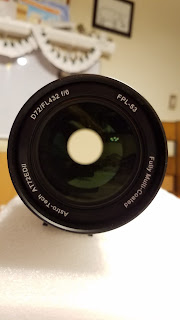Wow! This little scope is a
major step up from the ST80.
There is a lot that I want to cover in this post, so bear with me, please. If you're just here for the pictures, then skip down a bit.
The AT72EDII is an air-spaced doublet refractor with an FPL-53 element. The lenses are made by
Ohara. The FPL-53 lens makes a huge difference in correcting chromatic aberration, rendering sharper images with much more realistic colors--closer in hue to those that I have gotten from the
Epsilon-200. In comparison, I thought the colors I was getting from the ST80 were somewhat "cartoonish," even with the Baader Contrast Booster.
Here is the rig as it was on the night of
first light. Using a little of my redneck engineering skills, I cobbled together a viewfinder mount out of plywood and plastic.
A new telescope calls for a new
focusing mask, right? Using the
astrojargon Bahtinov Focusing Mask Generator, I printed the mask on card stock, then mounted it to a cap made of more card stock, peel-and-stick foam, and duct tape. It fits over the end of the dew shield.
 |
| Yes, I used duct tape. |
So, after getting everything put together, the mount aligned, and the focusing mask in place, I pointed the scope at Deneb to set the focus. There wasn't a lot of interest to see during the focusing process, but when I took a 30 second exposure with the mask still on, I got this:
 |
| Diffraction spikes on Deneb. Aside from being reduced in size, this is an unprocessed image. |
Note the lack of spurious color as compared to these images from the ST80:
I knew that I was in for a treat! So, I took off the mask and made a single, 30-second exposure of Deneb:
 |
| Unprocessed, resized image. |
Yes, there is a bit of a halo around Deneb, at center, but it is far less prominent (and less purple) than similar images that I've taken with the ST80.
I wanted to image the Double Cluster in Perseus, first, but it wasn't in a good position for the mount when I started. So, I decided to grab a few images of Messier 45, the Pleiades, until the Double Cluster was a little higher in the sky.
Exposure: 10x180@ISO1600
Telescope: AT72EDII
FF/Reducer: ATR8 (f/4.8)
Mount: Vixen Super Polaris
Camera: Canon EOS Rebel T3
Processing: Deep Sky Stacker, Photoshop CS6
This is a close-up (full-size) of a portion of the nebula:
I admit that, at a quick glance, there isn't a lot of difference between this image and what I think is my
best image of the Pleiades made with the ST80. A close look, though, will reveal that the new image has more detail and better color balance. In addition, it took A LOT of processing work to make the older image look like that--there were a lot of problems that had to be dealt with. Frankly, I wouldn't have posted a close-up of the older image. It just didn't look this good at full size!
The Double Cluster finally got high enough to image, but the Moon was only about an hour away from rising. Working quickly, I settled on a relatively short exposure time. Very little processing was required for this image:
Exposure: 20x90@ISO1600
Telescope: AT72EDII
FF/Reducer: ATR8 (f/4.8)
Mount: Vixen Super Polaris
Camera: Canon EOS Rebel T3
Processing: Deep Sky Stacker, Photoshop CS6
Cluster NGC 869 contains an asterism that I call Perseus Man. Some call it
The Cowboy.
Now, for the negatives.
The scope is difficult to balance on the declination axis on the Vixen Super Polaris. Judging by the subs that I got, this is probably not a big issue. After all, the mount only has a right ascension motor, and I'm not autoguiding.
The only troubling issue has to do with the ATR8 field flattener/focal reducer. It was advertised as providing "images that are sharply focused out to the very corners of a large format DSLR chip." Although much better than the ST80 (with no flattener), the images still have distorted stars out toward the edges, as seen in this full-size clip from the Deneb image, above:
I'm not certain of the cause. I wonder if I didn't install the T-ring correctly. It's also possible that the flattener doesn't perform quite as advertised. I will do some investigation and testing.
Other than that, I am very pleased with the results. With the winter constellations coming up, there are a lot of targets to image. So what's next? Sword of Orion? Horsehead and Flame? Monkey Head? M35? Dare I try the Flaming Star or the Christmas Tree? I think a return to the
X Bar Ranch is in order.













